|
 |
|
|
|
|
|
|
|
|
|
|
|
|
|
|
|
|
|
| Temples of Delhi |
|
|
| About Delhi |
|
|
 |
|
| Travel Destinations Guide |
|
|
| Adventure Tours India |
|
|
|
|
 |
Biking Tours |
 |
Paragliding |
 |
Skiing |
 |
Safari Tours |
 |
Water Rafting |
 |
Trekking Tours |
 |
Camel Safari |
|
|
| |
|
|
|
|
| |
|
| |
|
| |
 |
|
|
|
|
| Goa " Land of 4Cs - Churches, Casino, Cuisine And Carnival
" |
|
| Back |
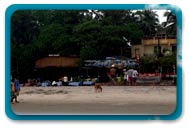  Towns & cities Towns & cities
Arambol : The largest coastal village in Pernem district, and the only one really geared up for tourism, is Arambol or Harmal, 32km northwest of Mapusa. If you're happy with basic amenities but want to stay somewhere lively, this might be your best bet. The village's two beaches are beautiful and still relatively unexploited. Parties do occasionally happen, drawing visitors across the river from Anjuna and Vagator, but these are rare intrusions into an otherwise tranquil, out-of-the-way corner of the state. Arambol is an ideal place to spend some time in total peace and tranquility. The cool sea breeze here and the swaying palm trees create a perfect holiday atmosphere.
Candolim : Candolim beach is located 14 km north of Panaji, is the longest and quietest stretch to the northern coastline. The long extension starts from Fort Aguada and ceases at Chapora Beach. The beach is not same popular as Calangute but the serenity draw many tourists. Not only the lusty beach but Portuguese Fort Aguada is also add glory to the place. The sandy coastline stretches to Calangute beach, a busy and commercial center. The place is a good escape from the travelers who just want to spend some good time in a ghostly serenity. The place is also a nice place to indulge in water sports.
Fort Aguada :
It is the starting point of the beach. Built in 1612 to protect the northern shores of the Mandovi estuary from Dutch and Maratha raiders, the bastion encloses several natural springs, the first source of drinking water available to ships arriving in Goa after the long sea voyage from Lisbon. The ruins of the fort can be reached by road; follow the main drag south from Candolim as it bears left, past the turning for the Taj Holiday Village, and keep going for around 1km until you see a right turn, which runs uphill to a small car park.
Canacona : Set against a backdrop of the lush green Sahyadri Hills and enfolded by laterite headlands, the beauty of Canacona augments with a string of pearl white coves and sweeping beaches that scoop its indented coastline. It is this virgin quality that has attracted enervated tourists - tired of rave parties, chattering cruises and beach bums - to the green carpeted hills of Canacona, nestling at 37 km from Margao.
Mapusa : A small town clustered around the Mount (Alto), Mapusa is the place from where you can buy things of every day need. It forms the hub of North Goa with an even blend of residential and commercial establishments. Its 13 kms away from Panaji, a share-taxi or a bus will take you there. Known popularly for its Friday market, people from all over Goa come here to buy and sell their wares. The bustling market of Mapusa stocked with almost all types of items is one major attraction of the state.
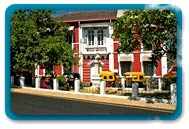 Panaji : It is the capital of Maharashtra state, and its official language is Marathi although English and Hindi are widely spoken and understood. The fast-paced life has given rise to hordes of "fast-food outlets" on almost every road, offering lip-smacking choices of Mumbai's very own pau bhaji, bhel puri and kababs. There is no dearth, though, of multi-culinary delicacies dished out in posh restaurants by expert chefs. Mumbai is a shopper's delight with bargain buys, exclusive boutiques, ethnic markets and mini bazaars. This busy city is also the hub of a thriving cultural life, with a constant stream of performances in music, dance and drama. The seat of the Hindi film industry, known locally as Bollywood, it produces the largest number of films in the world. Mumbai caters to the adventurous and the romantic through its sporting activities, nightclubs, pubs, theatres, beaches and restaurants. Old and new, rich and poor, classical and modern -- its all here for you to savour and enjoy! Panaji : It is the capital of Maharashtra state, and its official language is Marathi although English and Hindi are widely spoken and understood. The fast-paced life has given rise to hordes of "fast-food outlets" on almost every road, offering lip-smacking choices of Mumbai's very own pau bhaji, bhel puri and kababs. There is no dearth, though, of multi-culinary delicacies dished out in posh restaurants by expert chefs. Mumbai is a shopper's delight with bargain buys, exclusive boutiques, ethnic markets and mini bazaars. This busy city is also the hub of a thriving cultural life, with a constant stream of performances in music, dance and drama. The seat of the Hindi film industry, known locally as Bollywood, it produces the largest number of films in the world. Mumbai caters to the adventurous and the romantic through its sporting activities, nightclubs, pubs, theatres, beaches and restaurants. Old and new, rich and poor, classical and modern -- its all here for you to savour and enjoy!
Margao : Margao, or 'Modgow' in Konkani, the local language, was once a prosperous settlement and saw boats plying cargo to and from Middle East and Africa, even before the advent of the Portuguese. It was an important centre for trade, learning and religious activities with the 'maths' (schools of thought) of the Vaishnavas first established here. You can hear many stories in this bustling city, mostly related to the origin of name. Ask any local and he will tell you how Margao evolved from 'Matha-gram' when various monasteries followed in the medieval period, and how the name gradually changed from Madgaon to its current monicker, because the Portuguese were not very comfortable with hard syllables. All these things together with the cordial air of ancient Portuguese community, makes Margao a favourable place to spend a few days of your holiday vacation.
Vasco Da Gama : Goa's most cosmopolitan city, Vasco-Da-Gama, also known as Vasco. It lies on the narrow western tip of the Mormugao peninsula, overlooking the mouth of the Zuari River. Vasco da Gama is 29 kms southwest of Panjim, the state's capital and is one of the major tourist hubs of the state
Ponda : Also known as Antruz Mahal, Ponda is known as the Hindu heartland of Goa. It is so called because of the concentration of culture, music, drama and poetry. There are a large number of predominant Hindu temples and monuments. Ponda is just 28 km from Panjim, the state capital. It houses the temples of Lord Mangesh (Shiva), Lord Nagesh, Lord Ganapati, Lord Ramnath and the Goddesses Mahalasa and Shantdurga.
 Monumental Heritage Monumental Heritage
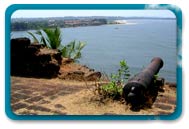 Reis Magos Fort : It is situated on the southeastern extremity of the tableland on the right bank of the Mandovi, in the province of Bardez, about two miles to the northeast of Fort Aguada. It was constructed in 1551by the Portuguese to guard the entrance to Goa at the narrowest part of the Mandovi river, enlarged subsequently on different occasions, and finally re-erected in 1707.
Though far inferior in size to the fortress of Marmugao, yet standing on an eminence, its commands, splendid view around. It is in a good state of preservation, and is defended by 33 guns and accommodation for a small garrison. Towards the east, at a little distance from it, flows a spring with abundance of excellent water, while at its base rises the church of the Reis Magos, ascended by a beautiful flight of stairs. Reis Magos Fort : It is situated on the southeastern extremity of the tableland on the right bank of the Mandovi, in the province of Bardez, about two miles to the northeast of Fort Aguada. It was constructed in 1551by the Portuguese to guard the entrance to Goa at the narrowest part of the Mandovi river, enlarged subsequently on different occasions, and finally re-erected in 1707.
Though far inferior in size to the fortress of Marmugao, yet standing on an eminence, its commands, splendid view around. It is in a good state of preservation, and is defended by 33 guns and accommodation for a small garrison. Towards the east, at a little distance from it, flows a spring with abundance of excellent water, while at its base rises the church of the Reis Magos, ascended by a beautiful flight of stairs.
Azad Maidan : This is a square piece of land with a central domed structure under which stood a bronze statue of Alfonso de Albuquerque, since moved to the state museum at Old Goa. It is now a memorial dedicated to Dr, Tristao de Braganza Cunha, a prominent Goan freedom fighter and another dedicated to Martyr's.
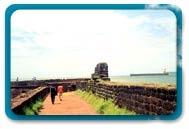 Aguada Fort, Goa : TIf you believe Goa is only about beach, wine and fun, check your memory. This thin strip of land was once the seat of power of the Portuguese, and hence it is not bizarre that one will find remnants of history sprawled all over the terrain. Erroneously forts have always been related to history. But these imposing edifices not only speak of yore, at least not in Goa. They shout for fun too. The pleasure of scaling the heights os a Goan fort to enjoy the view over the Arabian Sea or watch the setting sun turn its old ramparts to burnished gold can be an enriching change from beach lounging. Stretching from Tiracol Fort at the northern most tip of Goa, to Cabo da Rama Fort in the south, are remnants of colossal castles that once guarded Portugal's newly annexed territory from land and sea conquests. Remember, the forts of Goa were strategically located and strongly garrisoned to protect the entrance to the port or to the provinces around. Aguada Fort, Goa : TIf you believe Goa is only about beach, wine and fun, check your memory. This thin strip of land was once the seat of power of the Portuguese, and hence it is not bizarre that one will find remnants of history sprawled all over the terrain. Erroneously forts have always been related to history. But these imposing edifices not only speak of yore, at least not in Goa. They shout for fun too. The pleasure of scaling the heights os a Goan fort to enjoy the view over the Arabian Sea or watch the setting sun turn its old ramparts to burnished gold can be an enriching change from beach lounging. Stretching from Tiracol Fort at the northern most tip of Goa, to Cabo da Rama Fort in the south, are remnants of colossal castles that once guarded Portugal's newly annexed territory from land and sea conquests. Remember, the forts of Goa were strategically located and strongly garrisoned to protect the entrance to the port or to the provinces around.
Chapora Fort : Situated near the Anjuna beach, the Chapora fort was built by Adil Shah of Bijapur. The fort gives a spectacular view of the sea as it is situated atop a cliff, on the coast of the Anjuna beach. A few ruins here and there give a mystical look to it, though otherwise it has been well preserved. It was given a new dimension when the Portuguese took over and one can see traces of the Portuguese architecture in it.
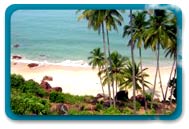 Cabo de Rama Fort : Cabo de Rama Fort has a long history and as the name suggests, it starts with Hindu warriors who constructed it initially and surrendered it to the might of the Portuguese in 1763. The fort which took its name from lord Ram from Ramayan was later renovated by the Portuguese by providing more bastions and citadel. However, the fort fell from grace and was lying in ruins till the State took notice and has prevented any further damage and deterioration of the fort. The fort affords a grand view of the entire length of Colva beach and the Canacona stretch. Some of the turrets of the fort still house the Portuguese cannons Cabo de Rama Fort : Cabo de Rama Fort has a long history and as the name suggests, it starts with Hindu warriors who constructed it initially and surrendered it to the might of the Portuguese in 1763. The fort which took its name from lord Ram from Ramayan was later renovated by the Portuguese by providing more bastions and citadel. However, the fort fell from grace and was lying in ruins till the State took notice and has prevented any further damage and deterioration of the fort. The fort affords a grand view of the entire length of Colva beach and the Canacona stretch. Some of the turrets of the fort still house the Portuguese cannons
 Goa Beaches Goa Beaches
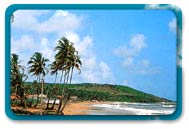 Anjuna Beach :Jagged laterite boulders welcome you to the land of Goan rave. Enchanting red cliffs kiss the silver white sand beach which is awash with crystal clear waters which splash relentlessly. The coconut plantation roof and plethora of restaurants and food joints offering food choices galore make the Anjuna beach a paradise on Earth. The famous full moon parties which provide an amazing opportunity for the visitors to taste a flavor of Goan entertainment are a big draw and the choice of food and heady mix of free flowing drinks and music is sure to corrupt any noble mind. The laid back attitude of the locals and the fun factor in air makes Anjuna beach trip memorable. Anjuna Beach :Jagged laterite boulders welcome you to the land of Goan rave. Enchanting red cliffs kiss the silver white sand beach which is awash with crystal clear waters which splash relentlessly. The coconut plantation roof and plethora of restaurants and food joints offering food choices galore make the Anjuna beach a paradise on Earth. The famous full moon parties which provide an amazing opportunity for the visitors to taste a flavor of Goan entertainment are a big draw and the choice of food and heady mix of free flowing drinks and music is sure to corrupt any noble mind. The laid back attitude of the locals and the fun factor in air makes Anjuna beach trip memorable.
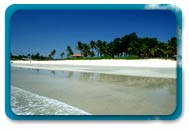 Benaulim Beach : One of the quietest beaches in Goa, Benaulim beach begins where Colva beach ends. A famous beach for fishing, Benaulim has remained largely undiscovered by domestic tourists. It's only in the evenings and on weekends that his charming beach gets somewhat crowded. Thus, Benaulim Beach in Goa can be the perfect getaway for you to bask the day off soaking in the sun and enjoy an idyllic vacation in Goa. Benaulim Beach : One of the quietest beaches in Goa, Benaulim beach begins where Colva beach ends. A famous beach for fishing, Benaulim has remained largely undiscovered by domestic tourists. It's only in the evenings and on weekends that his charming beach gets somewhat crowded. Thus, Benaulim Beach in Goa can be the perfect getaway for you to bask the day off soaking in the sun and enjoy an idyllic vacation in Goa.
Aguada Beach : Aguada beach is located in the north of Goa and 4km away from Sinquerim beach in Goa. With its exotic tropical beauty the pristine Aguada beach attracts tourists all over the world and India just like bees are attracted towards fresh blossoms. The people of frigid regions where sunrays don't reach adequately flock to India, especially Goa, for its vast array of sun-bathed beaches. That is the reason Goa beaches including Aguada beach look so colorful and vibrant with so many visitors of different regions of the world gathered together. However the sole attraction of the Aguada beach is the historical edifice- Fort Aguada built by the Portugese in the 16th century.
Dona Paula Beach : Dona Paula is 7-km from Panjim and is different from other Goan beaches in the sense that this is one of the beaches thatís washed by both the Goan sea and the goan rivers. This beach of Goa carries with it an aura of both romance and myth. It is said to be haunted by lost love of Dona Paula de Menezes. Dona Paula Beach is also house to the Governor of Goa, known as Cabo Raj Bhavan.
Chapora Beach : Located 14 kms north of Panaji in the state of Goa, the Candolim Beach is a part of a long extension of beach coastline along the Arabian Sea that begins at Fort Aguada and ends at Chapora Beach. This place is also famous as it is the birth place of Abba Faria, considered to be one of Goan freedom fighters and the Father of Hypnotism.
The white sandy Candolim beach naturally beautified by the scrub-covered dunes draws a lot of tourists these days. Candolim beach offers various water-sports activities-right from parasailing to water-skiing, wind surfing and so on. Fishing is an activity for those who love peaceful and quiet environment. Yoga & meditation has also gained popularity here because of the idyllic atmosphere.
 Art And Culture Art And Culture
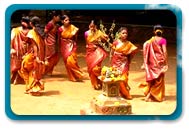 Goan handicrafts are made from the abundant natural raw material strewn all around its beaches and villages. You can get a sundry variety of shell artifacts - lampshade, jewellery, mirrors. The object d'art is interestingly the exquisite coconut shell items and is a must buy for every tourist to Goa. The local craftsmen fabricate an impressive array of designer arts - Ganesha's head or an old goan man- besides creating varied interior decoration items of tourist interest. Terracota heads the list of traditional art forms available in goa with vast selections made by the artisans from Kumbharvada in Bicholim. These range from pots planters and urns in a spectrum of shapes and sizes, to intricately crafted planters in tortoise, pig and toad form. Remember to look for some wooden lacquer articles in festive colours like green and red, popularly known as 'chitaris', dreamed up by master craftsmen from Cuncolim in South Goa. Goan handicrafts are made from the abundant natural raw material strewn all around its beaches and villages. You can get a sundry variety of shell artifacts - lampshade, jewellery, mirrors. The object d'art is interestingly the exquisite coconut shell items and is a must buy for every tourist to Goa. The local craftsmen fabricate an impressive array of designer arts - Ganesha's head or an old goan man- besides creating varied interior decoration items of tourist interest. Terracota heads the list of traditional art forms available in goa with vast selections made by the artisans from Kumbharvada in Bicholim. These range from pots planters and urns in a spectrum of shapes and sizes, to intricately crafted planters in tortoise, pig and toad form. Remember to look for some wooden lacquer articles in festive colours like green and red, popularly known as 'chitaris', dreamed up by master craftsmen from Cuncolim in South Goa.
During a Goan marriage, one can come across a number of awe-inspiring creations in fabrics. Starting from handmade needlework in a popular table cloth size of 6 ft by 4 ft, these splendid works trace their limits to embroidered bedsheets, cushions, covers and even batik spreadsheets. For jewellery lovers, there is an imposing collection of locally crafted beads in myriad hues - black, red, green and white - and contemporary designs, that enthralls every visitor. Get yourself a nice earring or bracelet, made from pure silver and sometimes set with semi-precious stones, heavily influenced by designs from Rajasthan and Gujrat.
|
| Back |
|
|
|
|
|
|
|
|
|
|
|
|
|
|
